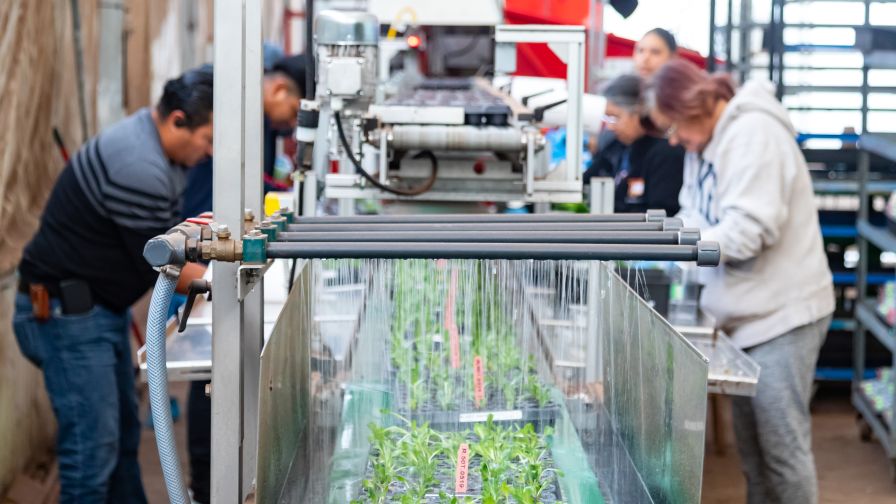How to Protect Your Greenhouse’s New Technology

Photo: Hortica
Greenhouses all around the country are adopting new technology and leaning into automation. With each innovation comes better precision, better efficiency, and better products. I left Cultivate ’23 amazed at how new tools have improved the plants we all enjoy.
But what happens when your technology fails?
Severe weather could cause a power outage. Hardware or software could fail. You may even purchase equipment with a design flaw.
The resulting crop loss, repairs, and time delays could stress your greenhouse’s finances. Let’s take a look at recent innovations, and then, explore what you can do to financially protect your business.
LED Lighting
LED lighting systems have led to more effective growing practices. Their energy efficiency make them an attractive choice for growers. By switching to LED lighting, many businesses see energy savings and improved crop quality. It’s even helped with pest control.
Automation
Smart technology has led to more connected greenhouse operations. Every aspect from temperature control and humidity to lighting and irrigation can be automated. It’s also one of the potential answers to the industry’s ongoing labor challenges. With higher efficiency, automation could unlock new levels of productivity for our industry.
Robotics
More recently, a few forward-thinking greenhouses have embraced robotics. This relatively new trend can handle responsibilities like plant placement and harvesting. By taking on more repetitive tasks, robotics can give your employees more time to focus on other areas of your business.
Solar Panels, Vertical Growing, and More
While the list could go on, my point is this: innovation takes place in our industry every day. We’ve seen a rise in solar panels, vertical growing, high-efficiency boilers, and more. All of these advancements shape today’s greenhouses. And for the purpose of this article, they all have one thing in common: When your business adds technology, it also adds financial risk.
Each of the tools I mentioned above share higher upfront costs.
But my point isn’t to discourage you from new advancements. Quite the opposite. Many of these tools provide long-term savings in addition to improving your operations.
Instead, I simply want to help you protect your greenhouse if technology breaks down or gets damaged. As our industry adopts more tools, it can create more dependency over time. That reliance can lead to:
- Extended downtime
- Higher repair costs
- Potential cyber risks
That’s where your insurance comes in. By reviewing your policy for the right type — and amount — of coverage, you can protect your greenhouse from unexpected costs and incidents.
Types of Insurance for Your Greenhouse Technology
- Commercial property insurance can help cover damages to your greenhouse’s equipment and technology. Think risks like fires, storms, or vandalism. This is one of the more standard coverages most growers have.
But with the cost of new technology — along with inflation — it’s important to talk with your agent to make sure you have updated values on the property you own. That way, if the unexpected happens, you have adequate protection to cover the increased costs of repairs and replacements.
- Equipment breakdown coverage can help cover costs associated with electrical and mechanical breakdowns that affect your technology. For your greenhouse, it’s one of the greatest risks. The sooner you get your equipment back to full strength, the sooner you can get back to fulfilling customer orders. That’s where this coverage can help.
- Business interruption coverage is designed to protect your greenhouse when critical equipment and technology cause a temporary pause in operations. Days can turn to weeks, and even months. During that time, business interruption insurance can help you cover lost income and operating expenses. With supply chain delays still happening, make sure you have enough coverage to account for longer timelines.
- Cyber liability coverage is now just as critical as the other protections I mentioned above. Greenhouses are more connected than ever before, from online data to connected tools. One breach could lead to significant costs. Cyber insurance can help you cover costs for legal expenses, notification costs, credit monitoring services, and more.
The Takeaway
Adding new technology involves planning for the future. The same goes for protecting your business.
By embracing new tools and investing in the right insurance coverage, you can position your greenhouse for success.
These tips should give you a head start, but it’s always best to chat with your agent or local experts. They can provide guidance and recommendations based on your greenhouse’s operations.
If you have any questions, please reach out anytime — I’m happy to help.









